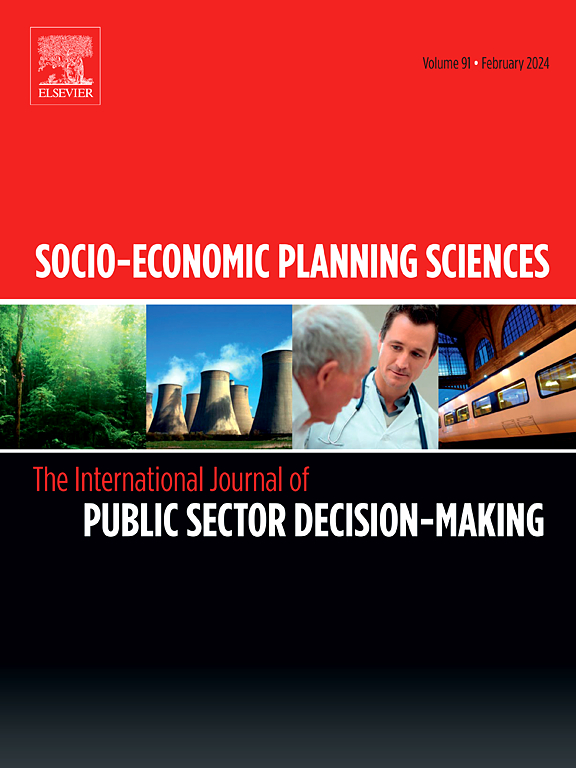A scenario robust Bi-objective model for integrating disaster mitigation and preparedness
IF 5.4
2区 经济学
Q1 ECONOMICS
引用次数: 0
Abstract
Policymakers often overlook the synergies between disaster management's mitigation and preparedness policies. We tap into this potential aided by a scenario robust bi-objective model we develop in this study. These competing objectives include mitigation costs associated with the readiness of a disaster-prone region and preparedness social costs consisting of logistics, deprivation, and fatality costs. We devote our attention to analyzing the tradeoffs with the minimization of these differing costs. Noting that disaster management settings typically present data accuracy challenges, we model uncertain parameters within each scenario using easily estimable deterministic uncertainty sets. We propose a novel framework that utilizes secondary data to estimate willingness to pay for essential goods such as food and water. Using this framework, we develop deprivation functions to account for human suffering due to shortages and delayed arrival of food and water supplies. Policymakers can gain valuable guidance regarding inter-system benefits using our models and insights from their practical deployment. Specifically, benefits accrued from a vertical collaboration between agencies handling mitigation and preparedness policymaking currently operating in silos, engaging in suboptimal policies. We illustrate our model application using an extensive case study featuring a hurricane-prone region. As an integral component of our analytical models, we deploy empirical models to estimate key parameters such as the readiness of the region. Our results provide fresh policy insights into collaborative strategies policymakers can adopt for effective disaster management through a cost-benefit analysis. Particularly, it can aid ethics boards of disaster agencies that provide guidance and oversight on ethical issues related to disaster response and recovery efforts with objective evidence.
将减灾和备灾结合起来的情景稳健双目标模型
决策者往往忽视了灾害管理的缓解和备灾政策之间的协同作用。我们通过在本研究中开发的情景稳健双目标模型来挖掘这种潜力。这些相互竞争的目标包括与灾害易发地区备灾相关的减灾成本,以及备灾社会成本,包括后勤、贫困和死亡成本。我们专注于分析这些不同成本最小化的权衡。注意到灾害管理设置通常会带来数据准确性方面的挑战,我们使用易于估计的确定性不确定性集对每个场景中的不确定参数进行建模。我们提出了一个新的框架,利用二手数据来估计支付食物和水等必需品的意愿。利用这一框架,我们开发了剥夺函数,以解释由于食物和水供应短缺和延迟到达而造成的人类痛苦。政策制定者可以利用我们的模型和从实际部署中获得的见解,获得有关系统间利益的宝贵指导。具体而言,处理缓解和备灾政策制定的机构之间的垂直协作所产生的效益目前各自为政,参与次优政策。我们使用一个以飓风易发地区为特征的广泛案例研究来说明我们的模型应用程序。作为我们分析模型的一个组成部分,我们部署经验模型来估计关键参数,如该地区的准备情况。我们的研究结果为决策者通过成本效益分析采取有效的灾害管理合作策略提供了新的政策见解。特别是,它可以帮助灾害机构的道德委员会提供指导和监督与救灾和恢复工作有关的道德问题,并提供客观证据。
本文章由计算机程序翻译,如有差异,请以英文原文为准。
求助全文
约1分钟内获得全文
求助全文
来源期刊

Socio-economic Planning Sciences
OPERATIONS RESEARCH & MANAGEMENT SCIENCE-
CiteScore
9.40
自引率
13.10%
发文量
294
审稿时长
58 days
期刊介绍:
Studies directed toward the more effective utilization of existing resources, e.g. mathematical programming models of health care delivery systems with relevance to more effective program design; systems analysis of fire outbreaks and its relevance to the location of fire stations; statistical analysis of the efficiency of a developing country economy or industry.
Studies relating to the interaction of various segments of society and technology, e.g. the effects of government health policies on the utilization and design of hospital facilities; the relationship between housing density and the demands on public transportation or other service facilities: patterns and implications of urban development and air or water pollution.
Studies devoted to the anticipations of and response to future needs for social, health and other human services, e.g. the relationship between industrial growth and the development of educational resources in affected areas; investigation of future demands for material and child health resources in a developing country; design of effective recycling in an urban setting.
 求助内容:
求助内容: 应助结果提醒方式:
应助结果提醒方式:


